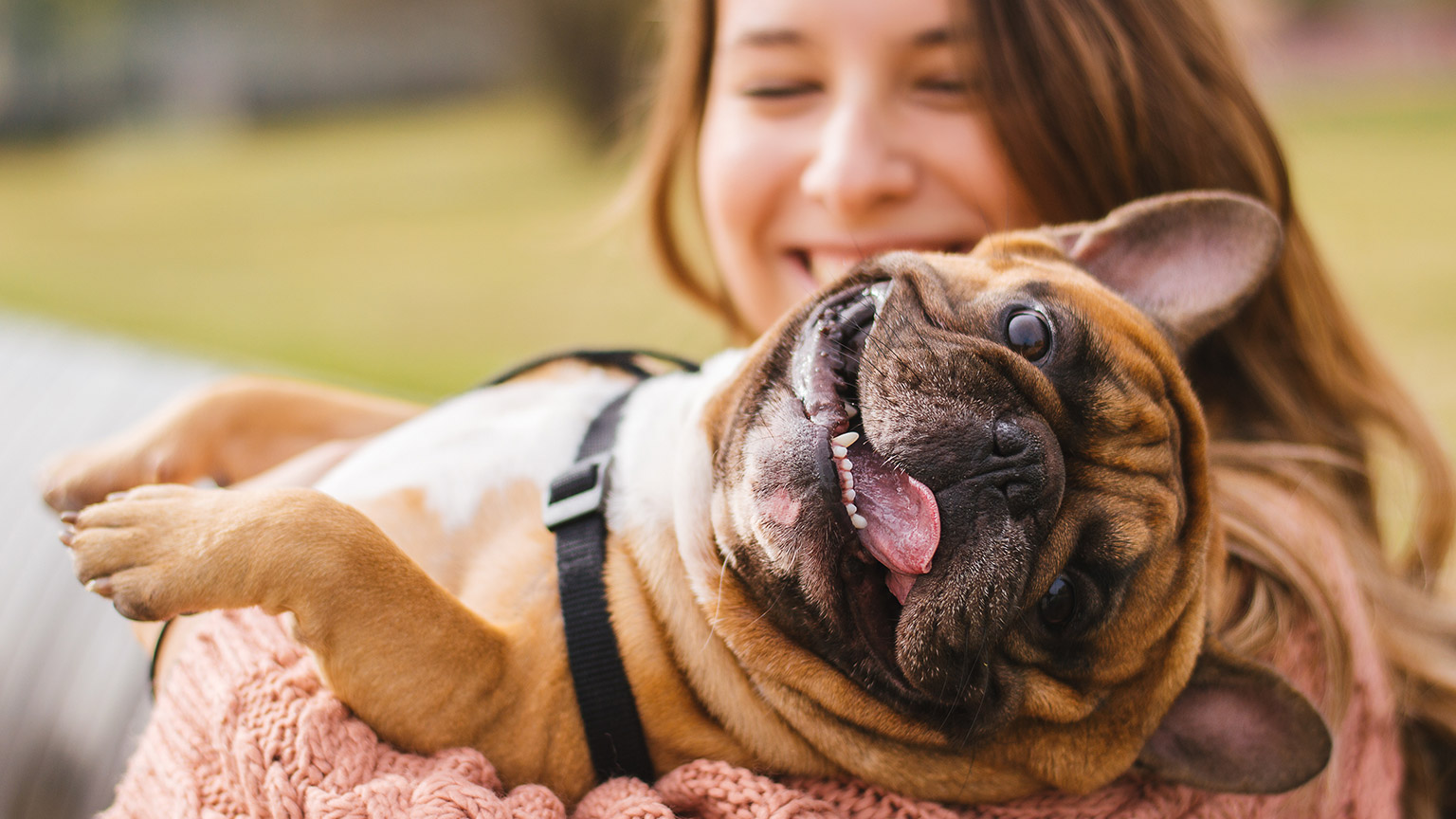In this topic we are going to look at:
- Dog breed groups
- Coat types and colours
Dogs (Canis lupus familiaris) were domesticated over 20,000 years ago in what is now modern-day Siberia when humans were still hunter-gatherers. They are the only animal to have been domesticated before the agricultural revolution. According to Wikipedia, the modern wolf (Canus lupus) is their closest living relative, but the actual ancestor wolf of dogs is extinct. Wolves and dogs are still closely related enough to be able to produce fertile wolf-dog hybrids.
Scientists are not sure exactly how domestication first occurred: it may initially have been accidental. During the last ice age, meat would have been in short supply as prey numbers died out from the cold and ice. Humans and wolves would have been in competition for the same prey animals and there may have been excess meat from human hunts that could not be eaten quickly. It’s possible that these humans may have taken in orphan wolf cubs and fed them on the excess meat that would otherwise rot. The process of breeding out the more aggressive traits of wolves would have slowly begun from this.
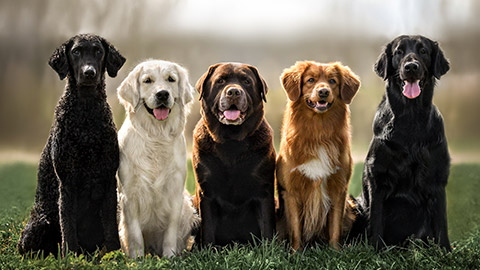
Given that dogs have been domesticated for longer than cats, it will be no surprise that the number of dogs breeds is much higher than cats. Depending on the different dog breeding organisations, there are over 500 recognised dog breeds. This number also includes breeds that are considered ‘extinct’ because they are no longer bred, or they have been bred into another breed line.
The criterion for determining a new breed is a little stricter than that of cats – given that the breeding of cats is more recent than dogs. For example, the American Kennel Club requires the following:
the new breed must have a population of at least 300 to 400 dogs, spanning a minimum of three generations. There must also be a national kennel club devoted to this new breed that includes at least 100 members spread out over no fewer than 20 states. The club must also have an established set of standards and qualifications that a dog must meet to be considered part of the breed
American Kennel Club, cited in Hill's
Another difference between cats and dogs is the way that breed groups are classified. Cat breed groups are determined by geographic origins and physical characteristics. Dog breed groups are determined by the job that the dog was originally bred to do. These categories are:
- Sporting (also known as ‘gundogs’, and used to hunt birds)
- Hound (used for tracking and location)
- Terrier (used for controlling small animals like rodents)
- Herding (used for controlling livestock like sheep and cattle)
- Working (used for work purposes other than hunting or herding)
- Non-working (this category is for breeds that don’t fit into the other categories)
- Toy (these very small dogs are usually bred for companionship rather than for work purposes)
We will look more closely at each category a little later on in this topic. Before we do so, we’ll look at coat types and colours as an understanding of this is also relevant to discussing the different breed types.
Single and Double Coats
Let’s talk about single and double coat first. In cats we saw that there were three (3) possible layers to cat fur: a soft, downy inner layer for warmth, a medium layer for warm and protection, and an outer layer for waterproofing. The two (2) layers in dog coats perform similar functions.
The undercoat layer is soft and downy and keeps the dog warm. The other layer of hair is thicker and stronger to protect the dog from water and dirt.
Some dogs only have one layer – these are the single coat dogs. This layer can be smooth or rough, short, long, wavy or curly, but basically the hair is the consistently the same length and texture all over the body. Whether the hair is long or short, single coat dogs need additional protection from cold weather. A dog jacket is essential in colder weather!
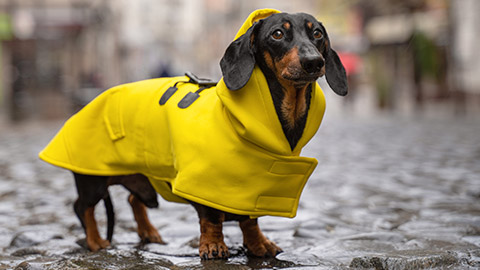
The good news about single coat dogs is that they tend to shed less hair than double coat dogs. The type of fur on a single coat dog often requires careful grooming, as the undercoat layer can easily matt. Grooming wet undercoat fur on single coat dogs is not a good idea as the hairs can easily break. Bathing single coat dogs can therefore be as infrequent as 3 to 4 times a year.
Double coat dogs have both a down layer and a thicker layer of guard hairs. These might be longer or shorter on different areas of the body, depending on the breed of dog. Double coat dogs shed more hair and may also molt (where the fur is completely replaced with new fur) the undercoat layer of their fur twice a year. Double coat dogs therefore need regular grooming. Matted undercoats are also an issue for double coat dogs if they are not groomed regularly – daily brushing is recommended. The features of double coats often mean a buildup of dirt, oil and bacteria leading to strong smelling fur (wet dog smell) so double coated dogs may need more frequent bathing than single coat dogs.
Curly Coat Dogs
Curly coat dogs have hair that forms either tight ringlets or a distinct curl. Wavy fur does not fit into this category. Curly coat dogs can be single coat (for example, poodles), or double coat (curly-coated retriever). Fur length can be short or long. Their fur is often soft and requires gentle grooming.
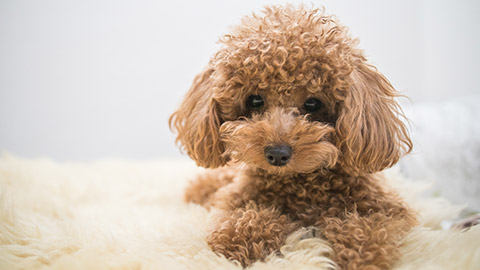
Silky Coat Dogs
Dogs with silky coats are like the hair shampoo models of the canine world. Their hair usually looks amazing: shiny, glossy and long and flowing. Silky coats can either be single (for example, Maltese), or double (for example, the Irish Setter). Fur length can be short, medium or long. Silky dogs with double coats will usually shed at least once a year, so need lots of grooming. Regular, daily brushing is recommended. Bathing requirements depend on whether the silky dog has a single or double coat.
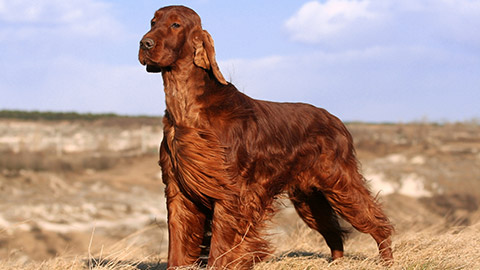
Rough Coat Dogs
Rough coated dogs can have medium or long fur that will always feel coarse in texture even if they look like dogs that should have soft fur. The rough texture of the fur gives them extra protection from weather like rain or wind. It is the outer layer of fur that tends to be coarse in texture so rough coated dogs usually have a double coat. They will need regular grooming as this type of coat attracts seed heads and can get matted quickly. An example of a rough coated dog is the Rough Collie.

Wire Coat Dogs
Wire coat dogs are similar to rough coat dogs. The texture of the fur is stiff and wire-like and often stands away from the body, especially on the tail, ears and face. They may have ‘moustaches’, ‘beards’ and ‘eye-brows’. Some wire coats noticeably shed fur, while others do not. They are generally short-haired dogs with a double coat that does not need frequent bathing. However, they do require a very specific type of grooming called hand stripping that removes old hair and allows new hair to grow. Hand stripping is a time-consuming task and requires a special kind of brush.

Smooth Coat Dogs
Smooth coat dogs have smooth and silky short hair that sits close to the body. They are often large and athletic looking dogs like Dalmatians or Great Danes. These dogs have fur that is the easiest to look after as the fur does not matt or tangle easily. Hair cells in smooth coat dog skins are usually closely packed together, meaning that although the fur is short, it still provides good insulation from the weather. In colder countries, a human-provided jacket may still be necessary to keep these dogs warm and healthy. Coats can be single (like Dalmatians) or double (like Pugs). Although smooth coat dogs are easy to groom, shedding can still be an issue, so regular brushing is recommended.
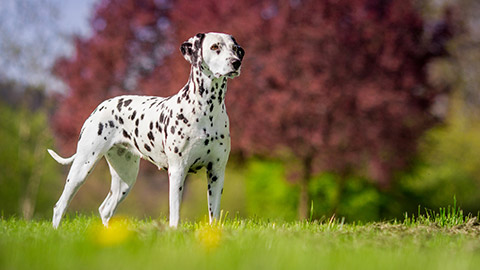
Hairless Dogs
Due to their absence of fur and reduced allergenic skin flakes/dander, these dogs are well-liked by people prone to allergies. Breeds without hair face greater risks with weather conditions and intense sunlight compared to their furry counterparts, meaning care needs to be taken to protect them from the sun. When bringing a hairless dog outdoors, it is crucial to apply canine-friendly sunblock. Regular bathing using a gentle dog shampoo and moisturising with dog-safe cream is essential to stop dry skin for these breeds. Even for brief strolls, hairless varieties need to wear a dog coat when venturing outside during winter.
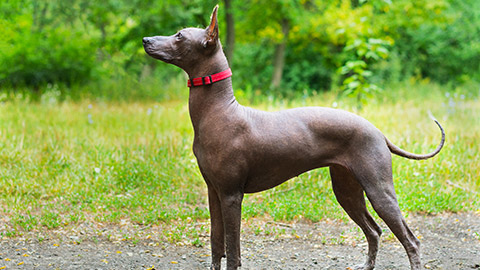
The picture above is of the Xoloitzcuintli, a Mexican breed of hairless dog. You can hear how to say its name in the following video.
Watch: How to Pronounce Xoloitzcuintli (0:27 Minutes)
Hypoallergenic Dogs
Hypoallergenic dogs can have almost any coat combination. It’s important to note that no dog is truly hypoallergenic as they will all still shed fur and skin to some extent. It’s just that the amount of shedding is much lower than in other breed types. Some people who are strongly allergic to dogs may still react to hypoallergenic breeds.
Mixed Breed Dogs
The words that we use to describe dogs of unknown or no particular breed are:
- Mixed breed
- Cross breed
- Hybrid
- Mutt (informal)
- Mongrel (informal)
- Cur (informal)

Like cats, dog coats come in a variety of colours and patterns. In some colour combinations the genes that determine coat colour also determine what colour the dog’s skin on areas like the nose and paw pads will be.
In many animals coat colour is determined by the Agouti Gene, which can cause hair cells to switch from making black or brown colours to yellow or nearly white. In dogs, the yellow colour (agouti) is dominant to the black colour. This means that dogs who have one parent with a black coat and one parent with a yellow coat are more likely to have a yellow coat.
Like cats, the main colours for dogs are red, black, and white – agouti colouring is genetically related to black as per above. From these base colours (and white) there is a very large range of shades of colours for dog coats - see the list on this website: Dog Coat Colour Genetics.
The main colour shades are:
- Brown/chocolate
- Cream/gold
- Grey/blue
- Tan
Coat Patterns
As well as many coat colours there are many coat patterns in dog breeds, some of which are nearly always a specific colour and pattern combination. Dog breeder organisations usually have very strict criterion about patterns of pure breeds. Dogs of no particular breed can also have a variety of coat patterns that are not given official names.
These are the main patterns. Scroll through the pictures using the left and right arrows at the bottom.
Now that we have covered the main coat colours and patterns we are ready to talk about the types of breed groups.
Form
As the name suggests, toy breeds are very small dogs. A general rule of thumb is that toy breeds are under 7 kg, but this also depends: different breeding organisations may have different size definitions and different lists of accepted toy breeds.
Toy breeds are often bred from other small dog types so their physical forms will resemble the original breed ancestors. Other than small size, there is no particular physical form that defines a toy breed. They can have different coat types and patterns, different tail and leg lengths (proportional to their bodies) and different face, nose and ear shapes. One thing that they do have in common is that they are often regarded as having a ‘cute’ appearance. This of course can be a matter of personal opinion!
Function
Toy dogs are not typically working dogs. Their main functions are human companionship; symbols of status or wealth; and being a show dog. Their size means they are perfect for sitting on a human lap or carrying around easily. The variety in forms reflects their largely ornamental purpose – other breed groups that we will look at have specific physical features in common that relate to a work-related function, but this does not apply to toy breeds.
Personality
These dogs provide human companionship, so a charming personality is usually desirable, although they can be excitable instead of chilled out. They are often affectionate and enjoy physical contact. When separated from their owner, they may become anxious. Because of this, they may need training to cope with being alone if their human owners need to spend time away from them. They may also need training to establish when it is acceptable to seek attention and physical contact from their owners: some toy dogs could become annoying in their expectation for constant contact with their human.
Natural Instincts
Many of the natural instincts of dogs have generally been bred out of toy breeds. These include hunting, herding, seeking and survival instincts, although some breeds may retain some basic hunting instincts. They can be quite dependent on care from their human owners due to the lack of these natural instincts. They are not usually aggressive but can become defensive if they feel threatened.
Social and Physical Requirements
Toy breeds often form close bonds with their human owner and may be quite disinterested in interacting with other humans or animals.
They do not have high needs for exercise, but still require regular exercise to keep healthy. Some toy dogs enjoy being taught simple tricks, games, or activities like obstacle courses. They can be very intelligent despite sometimes being difficult to train: remember they are bred for companionship, rather than performing work functions. The genes that make other dogs highly trainable may not be as strong in some toy types.
Grooming
The specific grooming needs will depend on the coat type of the toy bred. Toilet training can be difficult with some toy types that have fancy coat types. This is particularly true for long hair toy breeds who may need human help with keeping their fur clean after toileting.
Some toy breeds may find lots of handling to be overstimulating due to their small size, so human owners may need to spend time with them to establish that grooming is a pleasurable and rewarding daily pastime.
Breed List
Different breeding organisations have different lists of approved toy breeds. The most common types are:
- Spaniels
- Terriers
- Pinschers
- Poodles
- Chihuahuas
- Maltese
- Pugs
- Pomeranians
- Pekingese
- Bichon Frise
Explore
Here are some websites with different lists of toy breed dogs:
Form
Terriers are also generally small dog breeds, although they are larger than toys. Their small size and body features are linked very closely to their function as pest controllers. ‘Terrier’ comes from the Latin word ‘terra’, which means earth. They have strong legs for digging, and a strong jaw and teeth – they can kill prey with one fast bite. Terrier coats are bred to be weatherproof as they were traditionally dogs that spent time working outside.
Function
Terriers have a strong hunting instinct, and their prey is traditionally small animals like rodents. They are fast and agile, which is suited to chasing prey like rats and mice. They have a strong digging instinct, which makes them good rabbit hunters. Terriers are bred to be persistent when hunting, and they are also quite noisy, vocal dogs. This is a good feature to have – terriers will follow prey down tunnels and their tendency to bark when excited lets their human owners know where they are.
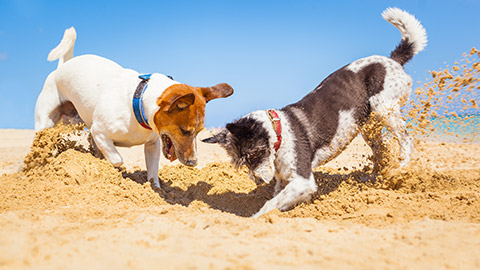
Personality
High energy is a good way to describe this group of dogs. They are brave and can be quite aggressive and have high levels of independence. Some people describe them as ‘argumentative’ and sometimes disobedient, and they can be challenging to train. ‘Friendly’ is not a great word to describe them as they may not show high levels of interest in stranger humans or other animals.
Natural Instincts
Terriers are naturally predatory, so even when not being used as a hunting dog, the instinct to hunt and kill prey will always be a key feature of this breed group. Owners should keep this in mind and find ways to meet this natural pattern of behaviour without neighborhood cats, rabbits and guinea pigs being in danger from the terrier’s instinct to kill. It is an important part of making sure that your terrier stays healthy and happy. Another key feature of Terriers is that they are territorial and will bark to protect/guard any area they claim as theirs. This can be good for human owners, but less so for neighbours or people walking past fences and gates.
Social and Physical Requirements
Traditionally terriers worked alone rather than in dog packs or groups. They may not respond well to the presence of other dogs and will need training and specific socialisation if they are being introduced to a family where there are other dogs. They will form good bonds with their human family but may not be a good choice for families with small children. This is because they could respond with aggression with small children who do not respect their boundaries. They also may become overstimulated when playing games with children due to their hunting instincts kicking in. This does not mean they make bad pets – it just means that both children and dog will need some training/boundaries in order to have a good relationship.
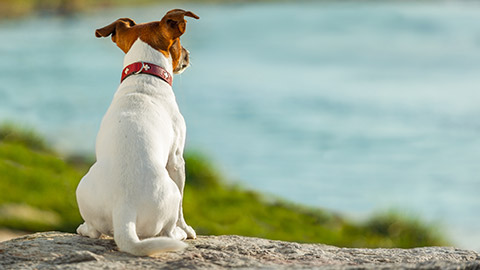
These are active and intelligent dogs and so boredom can be an issue resulting in behavioural problems and property destruction.
Physically they need more exercise than you would probably assume from their small size. They may make good running companions for humans who run regularly. Chasing balls or tug of war on a rope are excellent activities to keep them entertained and burn off some of their energy.

Their strong digging instinct could be a nuisance for owners if this is not trained out of them. They are also excellent escape artists, so Terrier owners will need to make sure their properties are securely fenced.
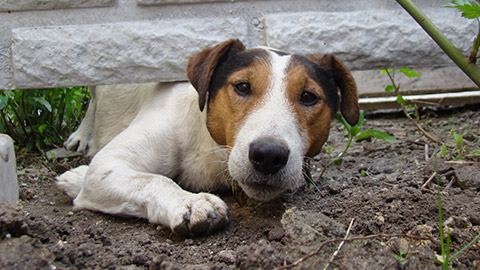
Grooming
Terriers usually have a coarse/wiry double coat and will need grooming to help strip out old hair and avoid undercoat matting to ensure that their coats and skin stay healthy. Handstripping, which all coarse/wiry coat dogs need, can be time consuming. Owners who don’t enjoy this job should seek assistance from a dog groomer. This should be done every four to six weeks depending on the specific breed of Terrier. Terriers with long tufts around the eyes may need these trimmed to prevent eye infections.
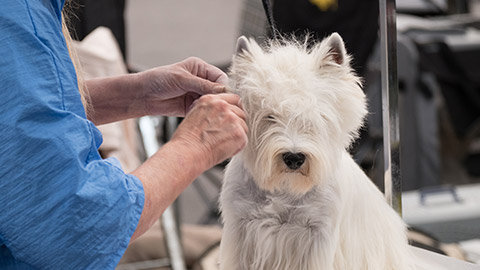
Breed List
Some common types of Terrier are:
- Airedale
- Boston Terrier
- Bull Terrier
- Fox Terrier
- Jack Russell Terrier
- Scottish Terrier
- Staffordshire Bull Terrier
- Yorkshire Terrier
Explore
Here are some websites with different lists of Terriers:
Note
The Pitt Bull Terrier has been banned from being imported into New Zealand since 1992 because of its potential for aggressiveness. Due to cross-breeding and natural similarities to Pitt Bulls some councils may ask owners to provide a breeder’s certificate to confirm their Staffordshire Bull Terrier’s lineage or genetic make-up.
Auckland Council, for example, regards Staffordshire Terriers as a Pitt Bull type of dog. See Menacing and dangerous dogs – Auckland Council.
Form
The term ‘gun dog’ is not meant to sound scary or threatening. It simply refers to the fact that these dogs were designed to work with humans hunting game with guns. Game usually (but not always) refers to bird species, so sometimes the term ‘bird dog’ is also used to refer to this breed group.
Gun dogs need endurance for the hunt, so they are usually athletic in form with strong legs and bodies. Although all dogs have a very strong sense of smell, certain nose/snout shapes in dogs are associated with a strong sense of smell. Generally, the longer the nose the stronger the ability to smell. Gun dog breeds mostly have a medium length and straight nose. Their ability to locate prey, flush it out, track it and then retrieve it once shot relies on a strong sense of smell.
Physically they range from medium to large size, although some spaniels are smaller dogs.
Many gun dog types are good swimmers, which is also a good match for their working role as many of the species they traditionally help hunt are water birds.
Coat colour and type varies across this breed group and is not necessarily related to their work function.
Function
There are three sub-groups of gun dogs, determined by the specific function they were bred for.
Pointers and Setters
Pointers tell their human hunters where the prey is by ‘freezing’ and ‘pointing’ in the direction of the prey. They will remain motionless in position until their human partner gives them the signal to move again. You can think of them as doggy arrow signs, pointing the way for humans to find their prey.
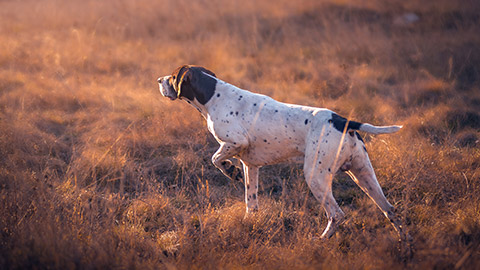
Pointers have a variety of coat types but are often spotted. Some pointer breeds are:
- Vizsla
- English Pointer
- German Pointers (which can be long haired, shorted haired, wiry or rough haired)
- Weimaraner
Setters perform a similar function but instead of pointing they ‘set’ their bodies close to the ground in the direction of the prey when they locate it. This helps them be less visible and therefore less likely to scare the prey away before the human hunter arrives. Setters will also carry their heads high because the scent of game birds is airborne – it is not necessary for them to follow ground scents like other dog breeds will.
Setters are often valued for their looks by breeders: they are characterised by medium to long hair coats that are often shiny in appearance. The four setter breeds are:
- English Setters
- Irish Setters
- Irish Red Setters
- Irish Red and White Setters
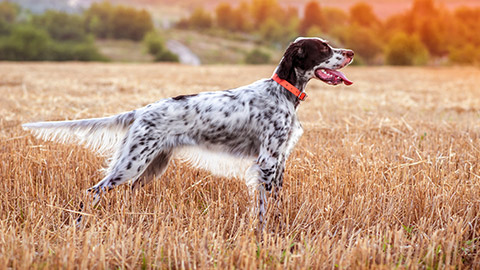
Flushing or Water Dogs
These are medium sized dogs with waterproof coats and a strong desire to swim. Their function is to ‘flush’ or chase out birds that will run from hunters or water-based game birds like ducks. Game birds are usually shot when they are flying, so the function of these dogs is to ensure the bird flies instead of running and hiding. Flushing dogs stay closer to their human partners than other gun dogs and will chase rather than point or set. These dogs will ‘mark’ the fallen prey when it has been shot and will then locate the bird and retrieve it for the human hunter. Good eyesight and spatial awareness on top of a sense of smell is required for this ability.
Flushing or Water Dog breeds include:
- American, Spanish, Portuguese and Irish Water Spaniels
- Poodles
- Pudelpointer

Retrievers
These dogs are bred to bring back or ‘retrieve’ prey once it has been shot. A ‘soft’ mouth is really important for Retriever breeds. This means that instead of biting, the dog holds the prey in its mouth without damaging it. This is in contrast to breeds like Terriers who bite to kill (a ‘hard’ mouth).
Retrievers primarily hunt water-game, so these dogs are physically hardy to cope with wet and cold conditions. Coats are usually double layered and waterproof but can be both long and short-haired and come in a range of colours and patterns. They are generally medium to large in size and solid and muscular in body structure. Good eyesight and spatial awareness are also key physical characteristics of Retrievers.
Retriever dogs can develop a truly extraordinary skill set with training, including:
- Discipline to remain under control when hunting.
- Marking downed game to find it easily.
- ‘Blind’ retrieving – following physical gestures and verbal instructions from humans to locate downed game that the dog has not been able to see when falling.
- Gently hold onto prey without biting until given the instruction to drop it.
- ‘Honouring’ other gun dogs working with the human hunter so as not to steal their prey.
- Shaking off water only when commanded (so prey is not disturbed by automatic shaking that most dogs do when exiting water).
- Working in set hunting patterns with other dogs and the human hunter.
Some common Retriever breeds:
- Golden Retriever
- Labrador Retriever
Personality
Gun dogs love everybody: you, your children, your cat, your neighbours, the postie, and your burglar (joke!). They are also hard working, active, social, outgoing and gentle dogs with easy-going temperaments. They respond well to strangers of both the human and dog type and have great co-operation skills, as they were bred to work with hunters and follow precise commands. Gun dogs enjoy training and are considered easy to train. For all of these reasons they are often used as guide and support dogs.
They can be extremely energetic if they do not get enough exercise or mental stimulation, but these traits are easy to manage with training and lots of exercise. Fortunately they are not usually noisy dogs as barking is not a desirable gun dog trait.
Gun dogs are a great choice for a family pet.
Natural Instincts
Hunting is hard-wired into gun dogs, and the urge to find ‘prey’ and bring it home is natural behaviour for them. Gun dog types that are kept as family pets should have this natural behaviour met through activities such as hiding, throwing and retrieving games. If not, your otherwise wonderful pet may act out these behaviours by chewing furniture and moving items around the house. Shoes in particular are the same size to many game birds and also tend to have a strong scent that gun dogs respond to! On the plus side, your gun dog could probably be trained to bring your morning newspaper from outside as well as your slippers when your feet are cold.
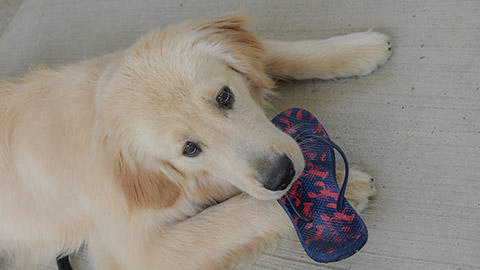
Social and Physical Requirements
Gun dogs are bred to spend many hours in close contact with their human hunters and other working dogs. This does mean that although they are great family pets, they can do less well spending time alone. Lack of attention can result in behavioural issues.
One negative issue to consider is that these friendly dogs may lack boundaries with other dogs and stranger humans. They may need training to observe appropriate physical distance from other dogs that might respond aggressively, and for humans who may be frightened by dogs who get too close to them.
An important thing to note for gun dogs kept as family pets is that if they are under-exercised they will gain weight easily. They love food and can be prone to over-eating, which will also lead to weight gain. They scavenge and will eat any food that they find around the house or garden. So keep rubbish bins securely closed and food out of reach. Exercise and appropriate food intake is necessary for their continued good health.
Grooming
Grooming needs will depend on the particular breed. Setters in particular may need more grooming than short-haired pointers. Golden Retrievers have longer fur than Golden Labradors, so matting will be more of an issue. As these dogs are easy to train, brushing and grooming from an early age should not be a problem and they enjoy this contact very much.
One issue: they usually love water and mud, meaning they get wet and dirty by choice. An outdoor bath or hose will be useful for owners. Acceptance of muddy paw prints everywhere will also be important if your gun dog shares your indoor spaces.
Explore
These websites have extensive lists of gun dog breeds:
You ain’t nothin but a hound dog, crying all the time.Elvis Presley
So what did Elvis mean exactly? Let’s see if any of the features of this breed group of dogs can shed some light on the famous song lyrics.
Form
Hounds range in size from small to enormous! They have excellent eyesight and an exceptional, even for dogs, sense of smell. Physical features that are associated with hounds are droopy ears, sad eyes and a large snout with jowls, although not all hound types have these traits. Some hounds have very long legs, while other types have extremely short legs: this depends on what work the breed was originally intended to perform. Long-legged hounds hunted with humans on horseback and therefore needed to be able to keep up with a horse’s pace. Short-legged hounds hunted with humans on foot.

Coat colours, type and pattern vary hugely. Some hounds have the black, tan and white ‘saddle’ pattern like the basset hound in the photo above, while others have solid colour coats. Some have very long hair; others have short hair. Hair length in hounds has a strong relationship to the kind of environmental conditions they were expected to work under. Hounds originally from cooler climates are more likely to have longer hair.
There are two types of hound, and they have distinct physical characteristics.
Scent Hounds
Scent Hounds hunt by smell. Some people joke that these hounds are noses with dogs attached. Most Scent Hounds have long drooping ears and drooping lips. There is a theory that the ears and lips help collect scent from the air and keep it near the dog’s nose, which also tends to have extra-large nasal passages. They are regarded as having high physical endurance for following prey over long distances, but speed is not a required trait for a scent hound. They often have short legs.
Scent hounds can be noisy – a useful hunting feature - and have a unique deep baying call that can be heard over very long distances.
Watch: Bluetick Coonhound Baying (2:40 Minutes)
Listen to the hound baying in this video. Is this the sound that inspired the Elvis song?
Scent Hounds will keep their heads close to the ground while following a scent. An upright tail, sometimes with white hair on the tip, is a physical trait that has been bred into this group – you can think of it as a flag or a sign-post so that human hunters can keep the dog in sight.
Common Scent Hound breeds:
- Basset Hounds
- Beagles
- Bloodhounds
- Dachshunds
Sight Hounds
Sight Hounds hunt by sight and speed. They have excellent vision, a very flexible back and long legs, a deep chest to support an unusually large heart, very efficient lungs for sprinting, and a lean, slim and light body. They also tend to have a long, sleek and aerodynamic looking head. These unique anatomical and physiological features are due to intentional breeding by humans for hunting.

Common Sight Hound Breeds
- Afghan Hounds
- Grey Hound
- Whippet
- Irish Wolf Hound
Function
Hounds are possibly the oldest hunting breed group of dogs, with records going back hundreds of years. Typical prey for hounds includes deer, hares and rabbits. They are highly focused and single-minded once they have a target and will hold attention to their prey for days if required to. Hounds have been used to track escaped human prisoners as well as their usual animal prey types.
Because hounds work at distance from their human owners, persistence and independence are more important traits than obedience. This is a key difference between gun dogs and hounds. In plain English, hounds are known for not following orders and ignoring their humans, especially when they are on the trail of something that interests them. This is a good thing when hunting something like a deer, which may run for days. It can be frustrating for human owners of pet hounds: the human wants to go home after a walk, but the hound will not come when called because it is following an interesting smell.
Another key difference between gun dogs and hounds is that hounds do not retrieve. Once their prey is cornered, they will stay with it until their humans arrive.
In the modern age, there is still plenty of work for scent hound dogs to perform. In particular, they are often found in border control, search and rescue, and working for police or other uniformed services. Sight hounds are mostly kept as pets now, although until fairly recently some were used as sporting dogs. Grey Hound racing is rapidly falling out of fashion in New Zealand, and many retired Grey Hounds require good homes to be adopted into.
Personality
Although gentle, sweet tempered and tolerant, hounds are quietly affectionate, can be aloof or distant and are independent pets who can cope with being left alone. They are good pets for people who want a dog that doesn't have high emotional needs. Training may be a challenge and take time and patience due to the independent and single-minded nature of hounds.
Natural Instincts
Hunting! Hunting! Hunting! They enjoy chasing and killing – which owners should be mindful of as these are natural behaviours that hounds will need to exhibit in order to be mentally healthy. They are used to being on the move but can also make good coach potatoes when not hunting.
Neighborhood cats or other small domestic pets will attract the attention of hound dogs, so training for urban-based dogs is important to avoid any accidental killing.
Social and Physical Requirements
While they get on well with other dogs, they are bred for independence and are fine as solo pets. Families with cats or other small animals should not consider getting a hound as they may not be able to control their hunting instincts with these animals. They will be fine with small children and strangers and are unlikely to bite or bark.
Both types of hounds need exercise so a large yard or access to open space is important, but they do not need as much daily exercise as some other dog breeds do. When not exercising, they may not be very active. Sight Hounds in particular will sleep a lot. Scent Hounds enjoy long walks in open spaces where they can follow their noses to things that interest them.
Unless they are well trained, it may be a good idea to keep your hound on a leash when walking in public as this will reduce the likelihood of them chasing small animals, or wandering off and not coming when you call them. Find a local dog park with good fencing to let them run off-leash.
Chasing, hide and seek type games and jogging are good activities for humans to participate in with scent hounds. Chasing after balls or sticks is also rewarding for sight hounds who will want to sprint – a ball thrower would be a good investment for these pets!
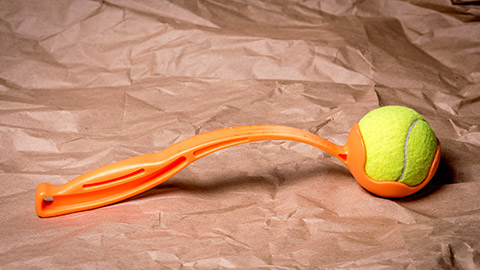
Grooming
In general, these dogs do not have many grooming needs. Owners should get them used to regular brushing as part of a good health care plan and for bonding between dog and human. However, some hound breeds are known to have a naturally strong doggy odour, so regular bathing may be needed for humans who are sensitive to strong dog smells.
Explore
These websites have extensive lists of hound breeds:
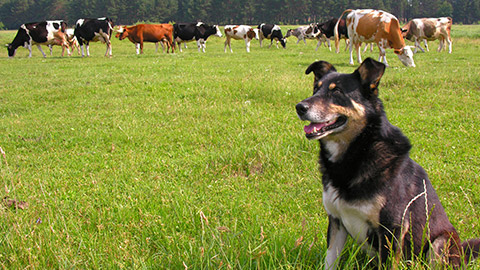
Form
‘Working dog’ covers a range of breeds that are not necessarily related to each other by breeding ancestry. Rather, they are grouped together because they ‘work’ to perform specialist roles rather than performing a specific hunting function like Terriers, Gun Dogs and Hounds do. These roles can be quite different from each other, so each working dog’s form will depend on the work they were bred to do.
One thing they generally have in common is that they are large dogs, and some are even regarded as ‘giant breeds’. In the past, ancestors of some of the dogs in this group were bred to hunt and kill large animals like bears, which gives you a good idea of the strength their descendants still have as a feature.
Coat types and lengths depend on the climatic features of the landscape they were bred to work in. In general, the colder the climate, the larger the dog and the longer and thicker the fur. Heavy shedding of fur is a feature of many work dogs breeds.
Function
As already mentioned, this breed group performs a variety of ‘work’ functions. These are:
- Guarding (property or livestock)
- Transportation (sled dogs)
- Police and Military assistance (tracking and capturing)
- Herding (livestock)
- Search and Rescue (war zones, emergencies like earthquakes, lost people)
We have already covered assistance/guide dogs which tend to be Gun Dogs rather than from this group.
Strength, power and size are requirements for all of these roles. We will discuss specific form and functions as we look at some of the different breeds in this group.
Guard Dogs
Property
Some of the breeds traditionally associated with being property guard dogs are:
- German Shepherds
- Doberman Pinscher
- Bullmastiff
- Rottweiler
- Akitas
These dogs look intimidating in both size and appearance. They are territorial and will bite to defend their people and property. They need to be brave and intelligent to carry out their guarding functions. These tough dogs may also be highly pain tolerant – which is useful considering they may come under physical attack while performing their guarding duties. Another feature of this group of working dogs is that they will bark to sound the alarm if they think their territory is being invaded.
Livestock
Livestock guard dogs defend livestock (like sheep or goats) from animal predators such as wolves, as well as from human thieves. Some of the breeds traditionally associated with being livestock guard dogs are:
- Great Pyrenees
- Bernese Mountain Dog
- Hungarian Sheep Dog or Komondor
- Mastiff varieties
These are BIG dogs! Being large provides them with a number of advantages:
- They retain heat longer which is important in cold climates.
- They carry more fat reserves and can go without food for longer which is necessary when they may be guarding stock in areas that are far away from human houses.
- They are less likely to get bone fractures and tolerate illnesses better – necessary if they are injured while protecting their livestock.
- Their stride is longer, so they are more efficient walking at long distances.
Livestock guard dogs are often bred to be the same or similar colour as the animals they are guarding. This is thought to be so that their human owners can tell them apart from wolves and not kill them accidentally. Being the same colour as the animals they protect may also keep the livestock calmer.
Transportation
Sled dogs are common in Arctic regions (Russia, Greenland, Scandinavian countries, and Canada) where snow is common for many months of the year. As the name suggests, they pull sleds as a means of transportation, performing the same function that horses would in warmer climates. Dogs, being meat-eaters, have an advantage over horses in cold climates because they can be fed on fish whereas horses require grass, which might be covered under meters of snow and ice. Some of the breeds of sled dogs have been around for over 1000 years. Common breeds include:
- Siberian Husky
- Alaskan Husky
- Alaskan Malamute
- Chinook
- Greenland Dog
- Samoyed
- Laika
Sled dogs can either be bred for size, strength and stamina, or speed and endurance. This means some dogs are ‘slow and steady’, while some move swiftly. They usually have a steady, consistent running gait which is important for working efficiently as a team when pulling a sled. A defining physical characteristic of sled dogs is large, webbed feet with closely spaced toes for gripping ice.
Dogs who have a slower pace will have thicker fur and a double coat to keep body heat in and moisture out, while dogs who are made for speed will have shorter hair to avoid getting too hot. Some sled dogs have a curly, bushy tail which can be used to keep their faces and legs warm while resting. Blood vessels in their legs also have a structural pattern that may prevent frostbite.
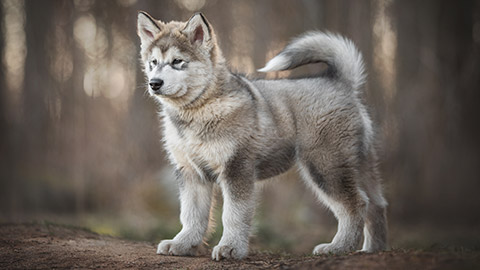
Police and Military
The main function of dogs that work with police and military services is the ability to track and hold down human suspects who are on the run from the law. They also are great at locating drugs, bombs and human remains. The type of dogs that typically work for the police are:
- German Shepherd
- Belgian Malinois
- Doberman Pincher
We have already discussed these dogs in the guard dog section, and the comments there are also relevant to the functions they perform in assisting the police. Other dogs such as beagles, bloodhounds, Spaniels and Labradors also perform important police work. Review the information about those dogs in the relevant sections of the learning content.
Herding
Herding dogs are found on farms all over the world. In Australia and New Zealand where the economy in the 20th century was based on agriculture and sheep farming, there are a number of herding dog breeds that are specific to this part of the world. These include:
- Australian Red and Blue Heelers
- New Zealand Huntaway
- The Kelpie
Famous herding dogs from other parts of the world include:
- Border Collie
- Old English Sheep Dog
- The Beardie
These dogs were bred from guard dog stock and share many of the physical and temperamental features. They are brave, strong, intelligent, persistent in a fight with a potential predator and great defenders of their livestock. Herding dogs usually share the following characteristics:
- Strong paws with thick pads to protect from rocks and sharp plants, and strong claws for grip on the ground.
- Thickly furred coats that protect from getting wet and temperature extremes.
- Excellent eyesight and hearing.
- Eyelids, lips, nose and paw pads that are darker in pigment to protect from sunburn.
- Fast runners over short distances.
- Some breeds will ‘nip’ to control stock, whereas other breeds will not.
- Some are noisy ‘barkers’ while others have a strong stare (for controlling stock with their eyes – see the following picture).
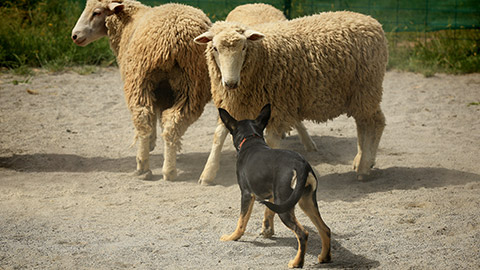
Search and Rescue
Dogs from all of the breed types we have already covered can be trained to be search and rescue dogs because of their specific traits. We won’t cover those details again here, but there are some breeds with perform specific working roles that we haven’t talked about yet. An example is the Saint Bernard, which is famous for rescuing people in snowy, mountainous environments. This is a large, very strong dog with a thick long coat.
Personality
Many working dogs are regarded as having an ‘A-type’ personality: outgoing, high-achievers that like to be in charge. They are strong-willed, determined and confident dogs that are not afraid of confrontation. They are not generally friendly dogs, although will bond strongly with the humans associated with their territory. They make good family pets but need more training because of their ‘A-type’ traits than other breed types like Hounds or Gun Dogs. Working dogs often need to be doing something, or boredom can set in which usually means behavioural problems.
Natural Instincts
These will depend on the job that they were bred for. Many working dogs have a ‘harder’ mouth that means biting can be something that will need to be managed with training. Other working dogs will have specific exercise requirements: guard dogs do not need as much exercise as sled dogs.
Guard dogs may often guard things you don’t want them to – like your favourite chair which they wish to claim as their own. Herding dogs may try to herd things like your children (not necessarily a bad thing but this might frighten very young children). Training for desirable traits is extremely important for most working dogs to ensure that the more assertive parts of their natural instincts are a good fit for the human environment they have been chosen for.
Social and Physical Requirements
Sled dogs who typically work in teams are the exception to this group of dogs which tend to work better alone than with other dogs. Some working dogs will form strong bonds with their owners, which can lead them to be over-protective and not good when left alone for long periods of time. Other guard dogs were bred to work alone on the job.
Naturally suspicious guard dogs should be socialised to cope with strangers so that walks in public places and visits to the vets and groomers are not problematic.
A good-sized outdoor space is recommended, with good fencing as some working dog breeds are natural escape artists.
Activities that keep them engaged include dog brain games such as these: Brain Games and Puzzles to Play with Your Puppy.
Working dogs do not generally have a strong instinct to chase sticks and balls and bring them back to you.
Grooming
Grooming can be a rewarding way of socialising your dog to being around humans and encouraging them to bond with you. Specific needs will depend on the breed: herding dogs have coats suited to working outside and may not need regular brushing or washing, while longer-haired breeds will need help with both. Shedding can be an issue for humans sharing their lives with working dogs, so grooming will help control this.
Summary
You now have a lot of new kupu/words for talking about dog breeds; the functions they perform for their human companions; the colours and coat patterns they have; and their temperaments. Let’s haratau/practice using this knowledge before we move on to the topic about rabbits.
Activity
What dog/dogs would be a good fit for you/your family based on the breed types discussed in this topic? Explain why in the Dog breeds forum thread, using some of the specific forms and features of your chosen breed type.
Activity
Choose five different breeds of dog and compare them by completing the table in this downloadable worksheet. One example is provided in the worksheet.
There are no right or wrong answers, but this exercise is a good way for you to think about the forms and functions of the different dog breeds and how this applies to human needs for companion animals. This is also good preparation for your assessment.
Case Study

Choosing a Companion Dog
Now that Zoe has her own dog walking business she has been studying up about the different dog breeds. This has come in handy because people are starting to ask her opinion about what kind of dog they should consider getting as a family pet. Here’s a few examples of the questions she has been getting via her business social media page.
“Kia ora Zoe! We are a couple in our fifties with no children. We’re downsizing from our city apartment and corporate jobs to a house in the country-side. We’ll have a decent yard, and lots of open space for exercise. We plan to do more biking, swimming and running because we will have more free time. What kind of dog do you think will suit our new lifestyle?”
“Hello Zoe. My wife recently passed away and I have moved to a small retirement village where I have my own cottage. It has a tiny garden and patio, but lots of paths for walking around the village. We’re allowed pets provided they will not be a nuisance for other residents. I think a dog would help keep me company because I miss my wife. Could you give me a recommendation?”
“Hey Zoe. Our neighbour has recommended you – you walk her dog Einstein. We are two dads with two boys aged 6 and 4. We have a house with a fully fenced off backyard. We’d love to get our boys a dog that they could play with and teach them about caring for an animal. We both work weekdays, so we know that we need a dog that won’t get lonely while we are away. We also want a dog that will be good with our boys. What dog do you think would suit us?”
Share
Now, step into Zoe’s shoes. What dogs would you recommend for each of these people? Share your thoughts in the Dog recommendation forum thread here.
